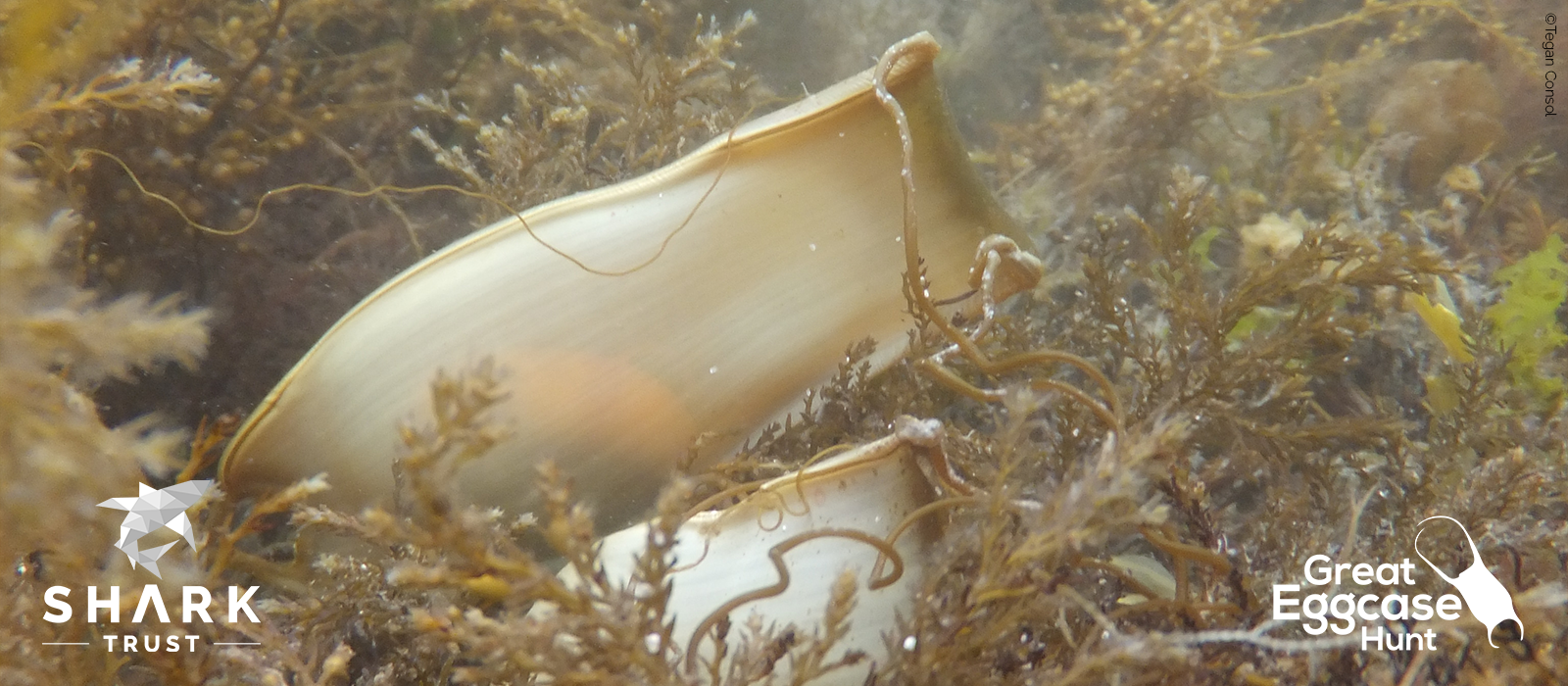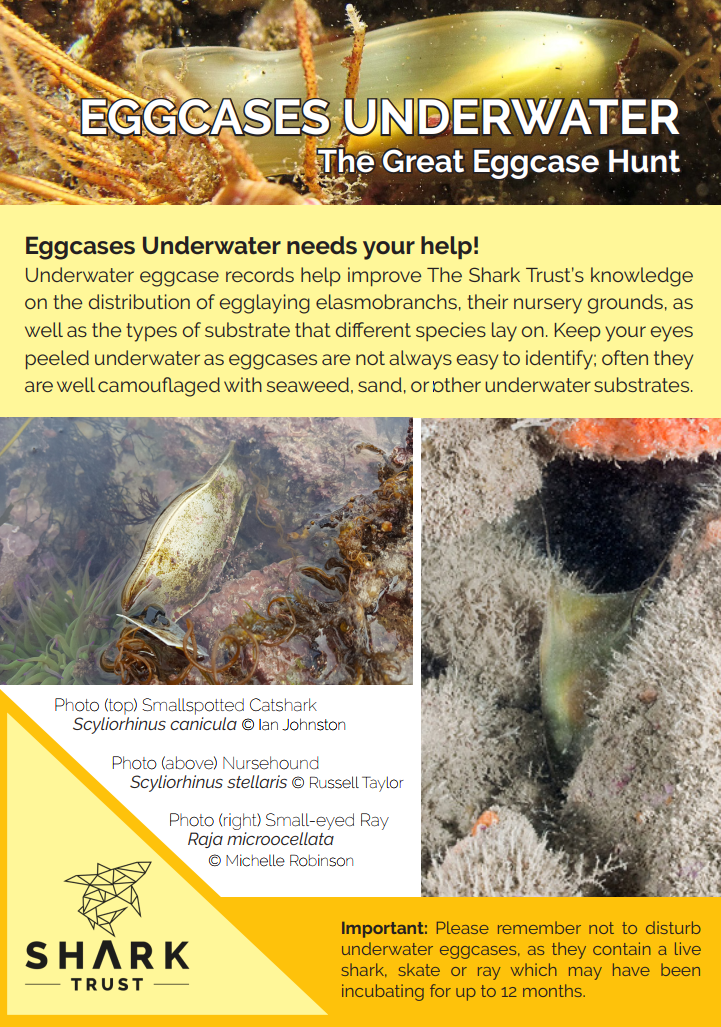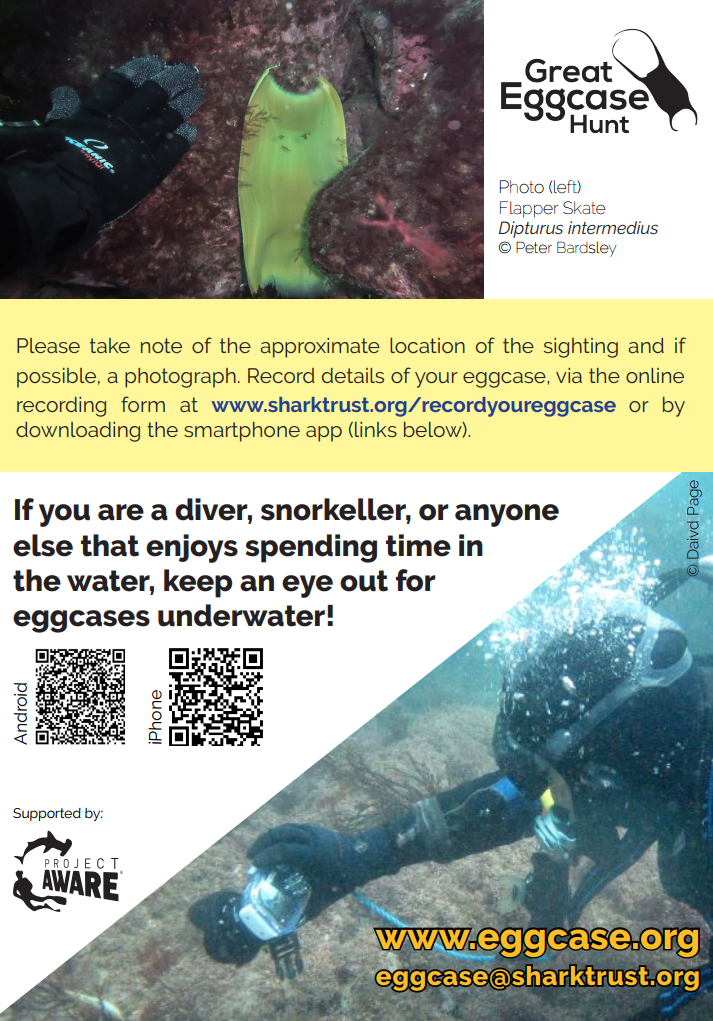Fins on for the Great Eggcase Hunt
Looking for another excuse to go diving? Record your sightings of shark, skate and ray eggcases

Divers are some of sharks and rays’ closest and most influential allies. They also have a unique skill set to take part in citizen science projects such as our Dive Against Debris® flagship program or the Shark Trust’s Great Eggcase Hunt. So, when the Shark Trust team contacted us to discuss ways to engage the dive community in recording underwater sightings of eggcases, it was with no hesitation that we decided to support the initiative.
 Like the Shark Trust, we believe in an evidence and science-based approach to ocean conservation and we understand that we’re stronger when we join our efforts together. We focus on the long term and we strive for sustainable and enduring results. But we can’t achieve results without support, fins on and fins off, from our global community. In this interview, Tegan Consol who is working on developing ‘Eggcases Underwater' as part of the Shark Trust’s Great Eggcase Hunt, answers all you need to know to get involved in the project with your fins on:
Like the Shark Trust, we believe in an evidence and science-based approach to ocean conservation and we understand that we’re stronger when we join our efforts together. We focus on the long term and we strive for sustainable and enduring results. But we can’t achieve results without support, fins on and fins off, from our global community. In this interview, Tegan Consol who is working on developing ‘Eggcases Underwater' as part of the Shark Trust’s Great Eggcase Hunt, answers all you need to know to get involved in the project with your fins on:
Why was the Great Eggcase Hunt project established?
The Great Eggcase Hunt is a citizen science recording project that encourages participants to hunt for eggcases, or ‘mermaids purses’ that have washed ashore. Established in 2003, the project was originally created as an educational tool to involve the British public in shark conservation. However, due to the overwhelming amount of public support it was clear that the Great Eggcase Hunt was capable of so much more, and able to provide valuable information regarding the relative abundance, regional diversity, and geographic distribution of sharks, skates and rays. It has also expanded beyond British shores and welcomes records from around the world. To date, just under 200,000 individual eggcases have now been submitted to the project!
 Why report eggcases? Why underwater?
Why report eggcases? Why underwater?
Despite washed up eggcases providing a remarkable amount of information on the distribution of oviparous (egglaying) species, these records do not always provide a true indication of where they were laid, as ocean currents can often carry them some distance. As part of ‘Eggcases Underwater’, the Trust wants to encourage more submissions of developing eggcases seen in situ by water users. Recording any underwater eggcase finds furnishes valuable information of exactly where species are laying, as well as the type of substrate that they are laying on- all this contributes to an improved understanding of oviparous elasmobranchs.
Why is the unique underwater skill set of the scuba diving community needed for this citizen science project?
Unfortunately, as a small team with many obligations, the Shark Trust cannot go out and find every egglaying site that’s accessible within snorkelling or diving depths. Instead, we need support from the scuba diving community to help us identify different areas where species are depositing their eggs. You could either arrange specific eggcase hunt dives in search of mermaids purses, or just keep an eye out during your normal diving adventures (although if you're quarry diving, I’m afraid you won’t spot any in the likes of Stoney Cove or Chepstow!).
What do you need to look for underwater to spot an eggcase?
There are 13 different species of sharks, skate and ray species that commonly deposit eggcases around the British Isles; 3 species of sharks and 10 species of skates/rays. With some encountered more regularly than others. The design of each eggcase is specific and you can refer to the Shark Trust’s Great Eggcase Hunt ID guide to identify your find. Eggcases from the Nursehound and Smallspotted Catshark are seen most often; they have curled tendrils which allow the shark to attach them to a seaweed. While skate/ray eggcases feature distinct horns that extend out of each corner of a rectangular case and are often concealed by rocks, sand and gravel- fewer in situ skate/ray eggcases are reported to the project.
How will the records submitted by scuba divers be used to support shark conservation?
Many shark, skate and ray species’ distributions are changing, and for some declining. By participating in Eggcases Underwater, your sightings data can be used to build a better species profile and fill in some knowledge gaps. In turn, this could even help contribute to better management measures for both the species and their habitats.
What is one of the most interesting things you've learned from the information reported so far to the Great Eggcase Hunt project?
This is a tough question to answer, as I personally have learnt so much from being involved in this project! The most interesting thing would probably be learning about the wide variety of eggcase designs that sharks, skates and rays lay. While some eggcases feature distinctive horns or curled tendrils that allow them to attach the developing young to the seafloor, others, like the Port Jackson shark, are designed to have a spiral flange around the case that allow them to wedge their eggs into a crevice.
Overall, the project has mapped out all the eggcase finds to date and these can be viewed through the results pages of www.eggcase.org or in the most recent report. Updated descriptions and a revised taxonomic key were published in 2016 and the eggcase results are currently being overlaid with data for adults and juveniles to see how these match up - so we’ll be able to answer more fully when we have finished analysing information for this!
Do you need to be a diver to participate in the Great Eggcase Hunt? Can snorkelers and freedivers participate too?
Anyone can participate in the Great Eggcase Hunt, and you don’t necessarily need to get wet! All that is needed is a beach and a keen set of eyes. To participate in the Eggcases Underwater element of the project, anyone that enjoys spending time in the water can get involved during their activity of choice - from diving to snorkeling to freediving, and even paddle boarding in shallow water to hunt for eggcases. All we ask from you is to please take note of the approximate location of your sighting and if possible a photograph. You can record your eggcases via the online recording form at www.sharktrust.org/recordyoureggcase or by downloading our iOS or Android smartphone app - just remember to select the ‘Found underwater’ box!
Can you report sightings outside of UK waters?
Yes! You can submit eggcase records from anywhere in the world. We have had eggcases submitted from almost every continent, but only a few have been underwater. Keep your eyes out for eggcases around the world and spread the word about the Great Eggcase Hunt.
Can you tell us a little bit about your partnership with Project AWARE?
The Shark Trust has collaborated with Project AWARE on many projects for well over a decade. As well as engaging with supporters in citizen science and contributing to diver speciality courses, it has also involved campaigning together in Brussels for tighter finning regulations, working in partnership during CITES and CMS, and as collaborating partners of the Shark League for the Atlantic and Mediterranean advocating for high seas fisheries management. Long may the partnership continue!



